Netherlands
Welcome to Netherlands
Step into a land where vibrant tulip fields stretch to the horizon, windmills dot the countryside, and canals weave through charming cities. The Netherlands, often affectionately called Holland, is a country that seamlessly blends old-world charm with cutting-edge innovation. Whether you’re drawn by its rich artistic heritage, lively urban centers, or tranquil natural landscapes, the Netherlands promises an unforgettable journey in 2025.
The Netherlands is a compact yet diverse country located in Western Europe, bordered by Germany, Belgium, and the North Sea. With a population of around 17 million, it’s renowned for its flat landscapes, extensive canal systems, and a culture that celebrates openness and creativity. The capital city, Amsterdam, is a global icon, but beyond its famous canals and museums, the Netherlands offers a tapestry of experiences-historic towns, modern architecture, sandy beaches, and lush national parks.
Dutch society is famously progressive and welcoming. English is widely spoken, making travel easy for international visitors. The country’s efficient infrastructure, from high-speed trains to well-marked cycling paths, ensures you can explore both bustling cities and serene countryside with ease.
Why Visit the Netherlands?
1.
A Unique Blend of History and Modernity
The Netherlands is where the past and future coexist beautifully. Wander through medieval city centers in Utrecht or Haarlem, marvel at the masterpieces of Dutch Golden Age painters in world-class museums, then step into Rotterdam’s futuristic skyline. The Dutch are masters of reinvention, and their cities reflect a dynamic blend of tradition and innovation.
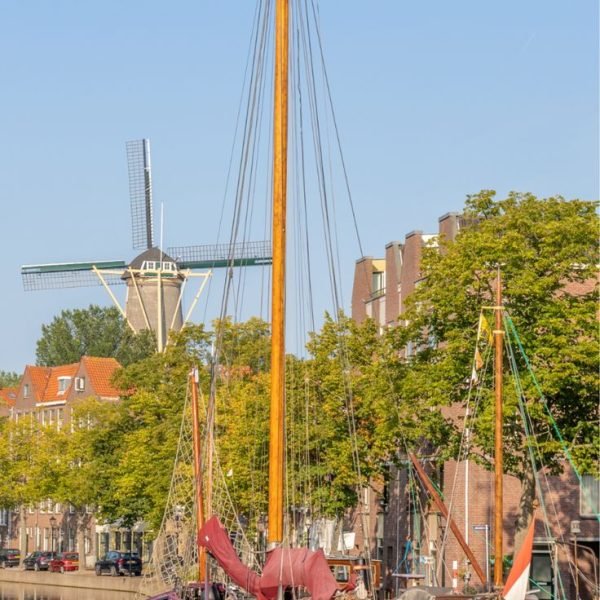
2.
Iconic Landscapes and Outdoor Adventures
From the famous tulip fields of Keukenhof to the windswept beaches of Zeeland and the tranquil waterways of Giethoorn, the Dutch landscape is as varied as it is picturesque. The country’s flat terrain and extensive cycling network invite you to explore like a local-on two wheels. If you’re an outdoor enthusiast, don’t miss the long-distance walking trails, such as the Pieterpad, or a visit to the Wadden Islands, a UNESCO World Heritage site known for its unique tidal flats and wildlife.

Planning Your Trip
Visa Information
The Netherlands is part of the Schengen Area. Citizens of EU countries, the UK, the US, Canada, Australia, and many other nations can enter visa-free for short stays (up to 90 days within a 180-day period). If you’re from a country that requires a Schengen visa, be sure to apply well in advance. For longer stays, work, or study, specific visa requirements apply-check with your nearest Dutch consulate for the latest regulations.
Best Time to Visit
The Netherlands is a year-round destination, but your experience will vary with the seasons:
- Spring (March to May): The country comes alive with blooming tulips, especially from mid-April to early May. Keukenhof Gardens and the flower fields are at their most spectacular. The weather is mild, though showers are common.
- Summer (June to August): Warm temperatures and long daylight hours make this ideal for outdoor activities, beach trips, and city festivals. Popular cities and attractions can be busy, so book accommodation early.
- Autumn (September to November): Enjoy fewer crowds, golden foliage in parks, and a cozy atmosphere in cafes. This is a great time for museum visits and exploring cities at a relaxed pace.
- Winter (December to February): While cold and damp, winter brings festive markets, ice skating on canals (if temperatures drop enough), and a magical ambiance in historic towns.
Getting To and Around
Getting To Netherlands
- Arriving by Air: Amsterdam Schiphol Airport is one of Europe’s busiest and most connected hubs, with direct flights from cities worldwide. Rotterdam The Hague Airport and Eindhoven Airport also serve international and regional flights.
- By Train: The Netherlands is well-linked to neighboring countries by high-speed trains, including Thalys (from Paris and Brussels) and ICE (from Germany). International rail travel is convenient and efficient.
- By Car: Driving into the Netherlands from Belgium or Germany is straightforward, with excellent highways and clear signage. However, parking in city centers can be expensive and limited.
Getting Around Within the Country
- Trains: The Dutch rail network is fast, frequent, and reliable, connecting all major cities and many smaller towns. Tickets can be purchased online, at stations, or via the NS (Dutch Railways) app. Consider an OV-chipkaart for easy travel on all public transport.
- Buses and Trams: Cities and towns have extensive bus and tram networks. These are especially useful for reaching suburbs, attractions, or smaller villages.
- Cycling: The Netherlands is the world’s cycling capital, with more bikes than people. Dedicated bike lanes, flat terrain, and bike-friendly infrastructure make cycling a joy. Rent a bike in any city and experience the country like a local.
- Boats: Explore Amsterdam’s canals by boat or take a ferry to the Wadden Islands. Waterways are a unique way to see the Dutch landscape.
- Car Rentals: While not necessary for city travel, renting a car is useful for exploring rural areas, the coast, or off-the-beaten-path destinations.
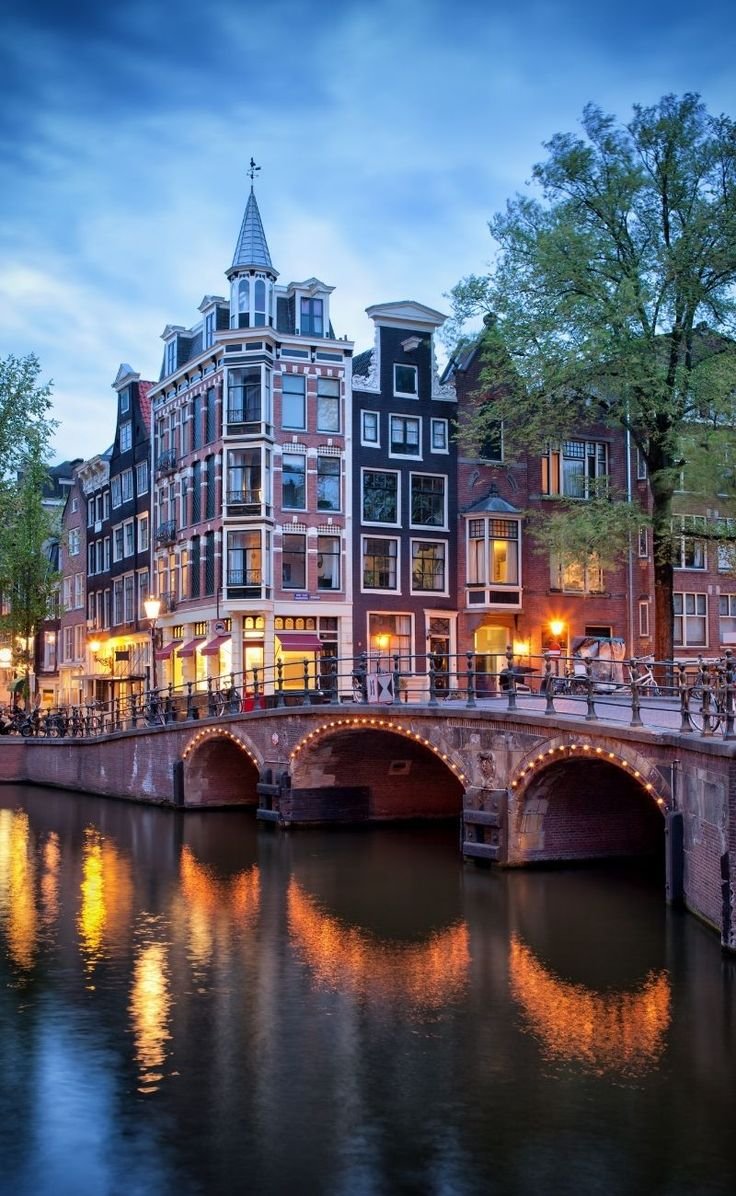
Accommodation
When planning your stay in the Netherlands in 2025, you’ll find a wide range of accommodation options catering to different budgets, preferences, and lengths of stay. Whether you prefer the bustling city center or quieter suburban neighborhoods, the country offers everything from budget hostels to luxury hotels, cozy bed and breakfasts, and unique stays like houseboats or converted camping pods.
Hotels and Hostels
The Netherlands boasts thousands of hotels across its major cities and tourist hotspots. Amsterdam, Rotterdam, The Hague, Utrecht, and Delft all offer a variety of accommodations ranging from budget-friendly to high-end luxury. For example, budget hotels like ibis Rotterdam City Centre provide clean, compact rooms with convenient access to public transport and city attractions, making them ideal for travelers seeking comfort without breaking the bank. On the other end, boutique hotels such as Kimpton De Witt in Amsterdam offer modern amenities, stylish interiors, and extras like free daily wine hours and fitness centers for a more indulgent stay.
Hostels and budget hotels are plentiful, especially in university cities and tourist areas, offering dormitory-style rooms or private rooms at affordable rates. These are great for solo travelers, students, or anyone looking to save on accommodation costs while meeting fellow travelers.
Apartments and Short-Term Rentals
For longer stays or those who prefer more privacy and flexibility, renting an apartment or a vacation rental is a popular choice. Monthly rents vary widely depending on the city and location. In Amsterdam’s city center, a one-bedroom apartment typically costs between €1,500 and €2,300 per month, while suburban areas like Amstelveen or Diemen offer slightly more affordable options starting around €1,200. Rotterdam and The Hague generally have lower rental prices, with one-bedroom apartments ranging from €1,100 to €1,800.
Keep in mind that short-term rentals like Airbnb are strictly regulated in many Dutch cities, especially Amsterdam, where short-term renting is limited to a maximum of 30 nights per year without special permits. This is designed to protect the housing market and ensure availability for residents.
Unique Stays
For a memorable experience, consider staying in one of the Netherlands’ unique accommodations. In Amsterdam, you can spend the night on a houseboat along the canals, combining comfort with an iconic Dutch atmosphere. Another option is the “indoor campsite” style hotel Outside Inn, which offers converted caravans, beach houses, and camping pods as hotel rooms, blending outdoor charm with indoor convenience.
Student Housing
Students planning to study in the Netherlands should start their accommodation search early. Universities typically do not provide housing directly, so students rely on private rentals, student housing organizations, or shared apartments. Monthly costs for student accommodation range from €300 to €900, depending on the city and type of housing. Shared housing and dormitories are common and affordable options, while private studios offer more privacy at a higher price.
Social Housing and Long-Term Rentals
Social housing (“sociale huur”) is a government-regulated option offering more affordable rents, generally capped around €800 per month. However, eligibility depends on income, and waiting lists can be long, so early registration is essential. For expats and families, long-term rentals in cities like Amsterdam, Rotterdam, and The Hague are available but can be competitive and pricey, especially in central locations.
Tips for Booking Accommodation
- Book well in advance, especially if traveling during peak tourist seasons or major events.
- Use trusted platforms and official hotel websites to secure the best rates.
- Consider staying outside city centers for better prices and a more local experience.
- Check cancellation policies carefully, especially for short-term rentals.
- For students, connect with university housing offices or student networks for advice and leads.
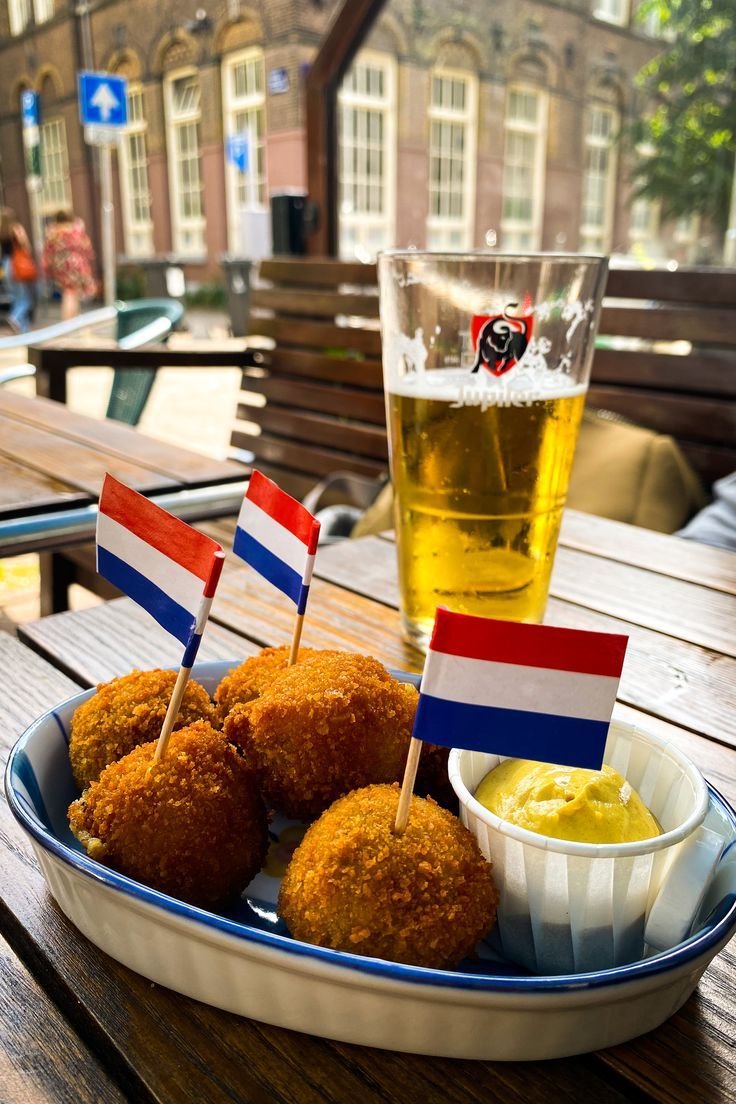
Food and Drink
Dutch cuisine is a delightful blend of hearty traditional dishes, fresh local produce, and international influences. Whether you’re grabbing a quick street snack or dining in a Michelin-starred restaurant, the Netherlands offers a rich culinary landscape that reflects its history and multicultural society.
Traditional Dutch Cuisine
Dutch food is known for its simplicity, wholesomeness, and comfort. Classic dishes often feature potatoes, vegetables, and meat or fish. Some must-try traditional foods include:
- Stroopwafels: Thin waffle cookies filled with caramel syrup, perfect with coffee or tea.
- Bitterballen: Deep-fried meatballs with a crispy exterior and savory ragout inside, commonly served as a bar snack.
- Haring (Herring): Fresh raw herring served with onions and pickles, typically eaten by holding the fish by the tail and taking a bite.
- Poffertjes: Small, fluffy pancakes dusted with powdered sugar, often enjoyed at markets and festivals.
- Erwtensoep (Dutch pea soup): A thick, hearty split pea soup with smoked sausage, perfect for colder months.
- Kroket: Similar to bitterballen but shaped like a cylinder, filled with meat ragout and fried until golden.
Modern and International Flavors
The Netherlands is a melting pot of cultures, and this is reflected in its food scene. Cities like Amsterdam and Rotterdam boast a vibrant array of international restaurants offering Indonesian rijsttafel (rice table), Surinamese dishes, Middle Eastern cuisine, and more. Trendy eateries and food markets showcase innovative takes on Dutch classics and global fusion dishes.
Cafés and Street Food
Dutch cafés are central to social life, serving coffee, beer, and light meals. Coffee culture is strong, with many cozy spots offering excellent brews alongside pastries and sandwiches. Street food is equally popular, with vendors selling fries (patat) topped with a variety of sauces, raw herring stands, and snack bars offering quick bites like frikandel (spiced sausage) and kroketten.
Beer and Drinks
The Netherlands has a long brewing tradition, famous for brands like Heineken and Amstel. Beyond commercial beers, craft breweries have flourished, producing a wide range of styles from IPAs to rich stouts. Beer tasting tours and brewery visits are popular activities.
For non-alcoholic options, Dutch apple cider (appelcider) and fresh fruit juices are widely available. Coffee and tea are staples, with many cafés offering specialty blends and artisanal preparations.
Dining Tips
- Tipping is appreciated but not obligatory; rounding up the bill or leaving 5-10% is common.
- Many restaurants offer lunch specials and early bird dinners at reduced prices.
- Reservations are recommended for popular restaurants, especially in larger cities.
- Markets such as Amsterdam’s Albert Cuypmarkt or Rotterdam’s Markthal are excellent places to sample local foods and fresh produce.
Food Festivals and Events
Throughout the year, the Netherlands hosts numerous food festivals celebrating local and international cuisine. King’s Day in April features street food stalls and festive treats, while autumn harvest festivals highlight seasonal produce. These events are perfect for tasting a variety of Dutch specialties in a lively atmosphere.
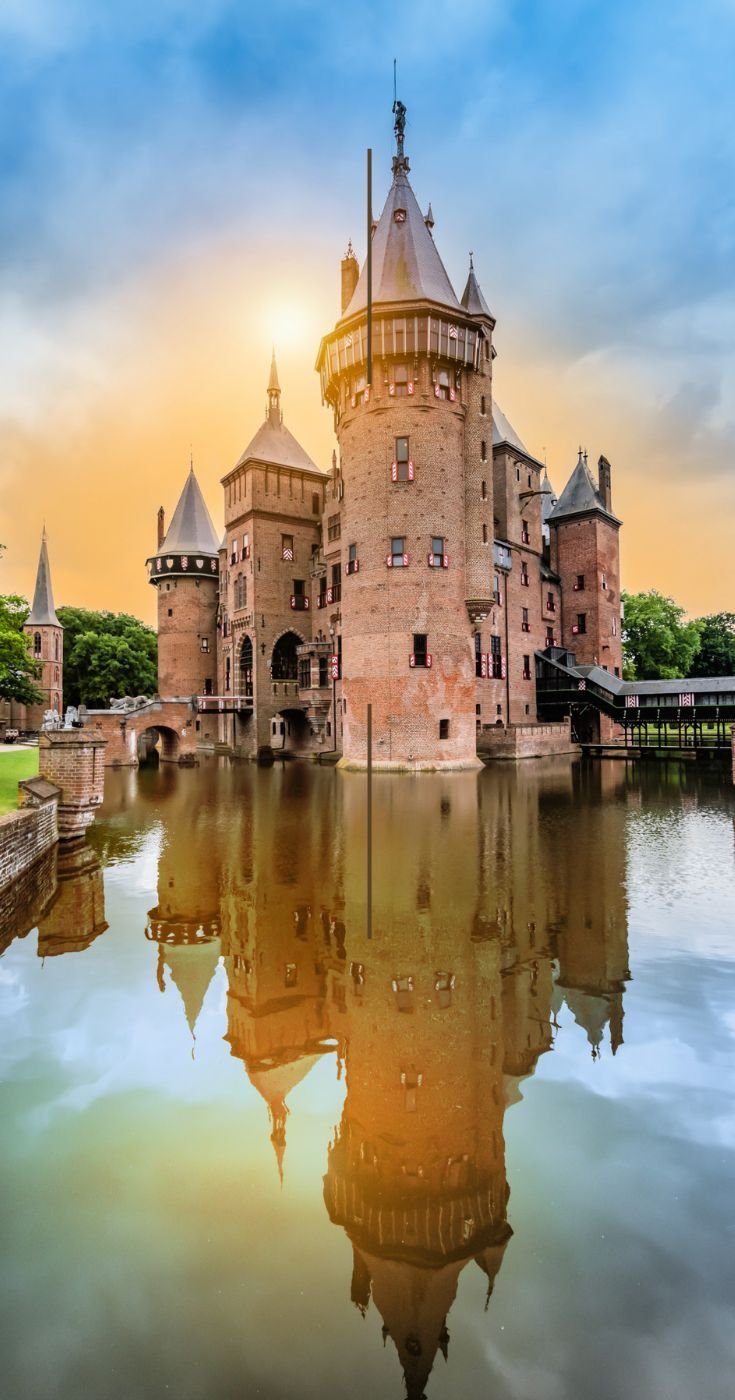
Must-See Attractions
Amsterdam’s Cultural Treasures
Amsterdam remains the crown jewel of Dutch tourism with its 17th-century canals and historic architecture. The Rijksmuseum is a must-visit, housing masterpieces by Rembrandt, Vermeer, and other Dutch Golden Age painters. Nearby, the Van Gogh Museum offers the world’s largest collection of Vincent van Gogh’s works, including iconic paintings like Sunflowers and The Bedroom. For a deeply moving experience, the Anne Frank House preserves the secret annex where Anne Frank and her family hid during World War II, providing a poignant glimpse into history.
The city’s unique charm is also found in its canal cruises, which allow you to relax while admiring Amsterdam’s picturesque waterways and historic bridges. For panoramic views, the A’DAM Lookout offers a thrilling experience with Europe’s highest swing, giving visitors a bird’s-eye view of the city skyline.
Historic Cities Beyond Amsterdam
- Delft enchants with its medieval Markt square, the Oude Kerk and Nieuwe Kerk churches, and the famous Royal Delft pottery factory. Climbing the church towers rewards you with stunning panoramic views, while the Vermeer Centrum Delft celebrates the life and art of the famous painter Johannes Vermeer.
- Utrecht is known for its well-preserved medieval architecture and the towering Dom Tower, the tallest church tower in the country. The city’s canals with unique wharf cellars, museums like the Centraal Museum, and vibrant café culture make it a delightful stop.
- The Hague (Den Haag), the seat of Dutch government and home to the International Court of Justice, offers historic landmarks such as the Binnenhof parliament complex and the Mauritshuis Museum, famous for Vermeer’s Girl with a Pearl Earring. The nearby Scheveningen Beach is perfect for seaside relaxation during summer.
- Maastricht, in the hilly southeast, boasts Roman bridges, lively squares like Markt and Vrijthof, and a rich culinary scene. Its Carnival celebrations are among the most vibrant in the country.
Iconic Dutch Landscapes and Heritage Sites
- The windmills of Kinderdijk, a UNESCO World Heritage site, showcase the Netherlands’ historic water management with 19 well-preserved windmills set against a scenic polder landscape.
- The Keukenhof Gardens, open from March to May, display millions of blooming tulips and other spring flowers, creating a breathtaking floral spectacle.
- Hoge Veluwe National Park offers diverse landscapes of forests, heathlands, and sand dunes, along with the Kröller-Müller Museum, which holds a significant collection of Van Gogh paintings amid nature.
- The Wadden Islands, including Texel, are ideal for beach lovers and nature enthusiasts, with opportunities for cycling, seal spotting, and water sports.
Modern Urban Highlights
- Rotterdam stands out with its innovative architecture, such as the cube houses and the striking Markthal food market. The Euromast Tower offers panoramic city views and the adventurous can even abseil down its side. Rotterdam’s vibrant public art scene and waterfront make it a dynamic city to explore.
- The Zaanse Schans open-air museum near Amsterdam brings Dutch heritage to life with historic windmills, traditional crafts, and wooden houses.
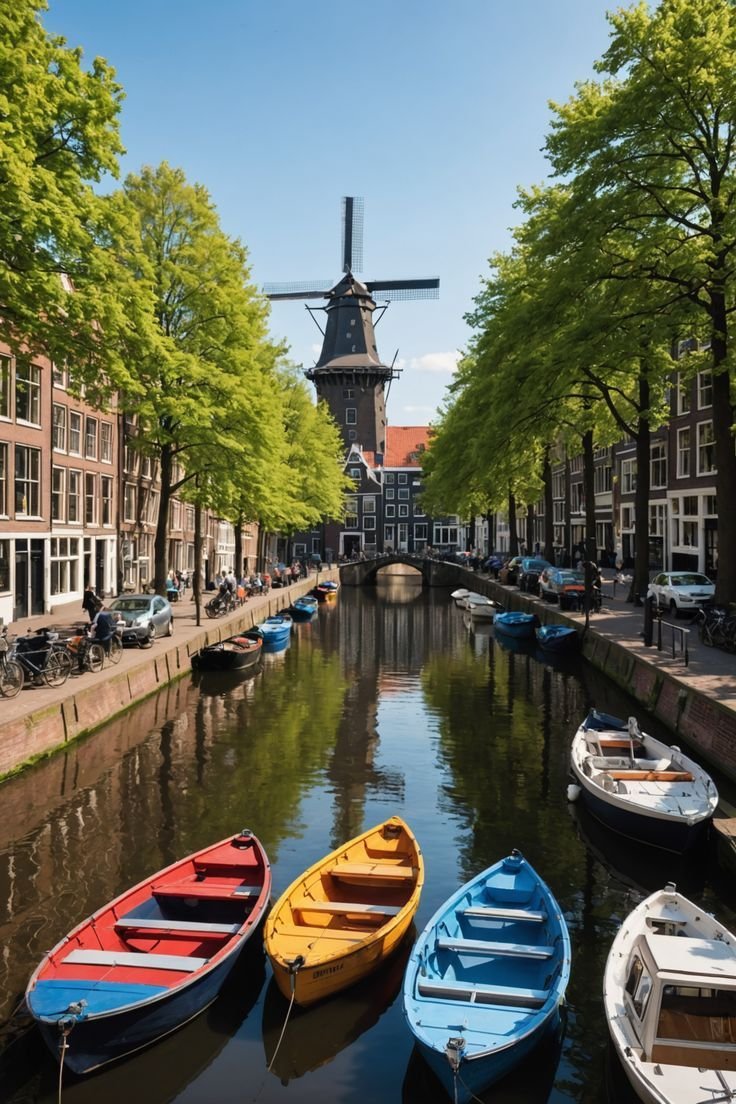
Must-Do Activities
Explore by Bike
Cycling is synonymous with Dutch culture. The Netherlands’ flat terrain and extensive network of dedicated bike paths make it the perfect country to explore on two wheels. Rent a bike in any city and pedal through charming neighborhoods, along canals, and into the countryside. Popular routes include cycling through the tulip fields in spring, exploring the dunes and beaches near the coast, or riding through national parks like Hoge Veluwe.
Canal Cruises and Water Activities
A canal cruise in Amsterdam or Utrecht offers a unique perspective of these historic cities. Choose from daytime sightseeing tours or romantic evening cruises illuminated by city lights. For a more active experience, rent a small boat or kayak to navigate the waterways yourself. On the coast and islands, enjoy sailing, windsurfing, or seal-spotting boat trips, especially around Texel.
Visit World-Class Museums
Immerse yourself in art and history by visiting the country’s top museums. Beyond the Van Gogh Museum and Rijksmuseum, the Stedelijk Museum in Amsterdam is a must for modern and contemporary art lovers, featuring works by Mondrian and Warhol. The Moco Museum offers provocative street art exhibitions, including pieces by Banksy.
Attend Festivals and Cultural Events
The Netherlands’ calendar is packed with vibrant festivals. King’s Day in April transforms cities into orange-hued street parties with music, markets, and parades. The Amsterdam Light Festival in winter illuminates the canals with spectacular light art installations. Other notable events include the Rotterdam International Film Festival in January, the North Sea Jazz Festival in July, and the Dutch Design Week in Eindhoven every October.
Sample Dutch Cuisine and Markets
Enjoy traditional Dutch foods such as stroopwafels, poffertjes (mini pancakes), and fresh herring. Visit local markets like Amsterdam’s Albert Cuypmarkt or Rotterdam’s Markthal to taste fresh produce, cheeses, and street food. Cheese tasting sessions in towns like Gouda and Edam offer a delicious insight into Dutch dairy heritage.
Climb Historic Towers and Lookouts
For breathtaking views, climb the Dom Tower in Utrecht or the church towers in Delft. The A’DAM Lookout in Amsterdam and the Euromast Tower in Rotterdam provide panoramic cityscapes and thrilling experiences like the highest swing in Europe.
Discover Dutch Traditions and Crafts
Visit places like the Royal Delft factory to see centuries-old pottery-making techniques. Explore the Zaanse Schans to witness traditional crafts such as clog-making, cheese production, and windmill operation.
Relax at Beaches and Nature Reserves
Spend a day at Scheveningen Beach or the sandy shores of the Wadden Islands. Hiking, birdwatching, and cycling in national parks like Hoge Veluwe or De Biesbosch offer peaceful escapes into nature.
The Netherlands in 2025 is a destination where history, culture, and nature come alive through its must-see attractions and must-do activities. From the canals of Amsterdam to the windmills of Kinderdijk, from cycling through tulip fields to enjoying world-class art, every traveler will find something to inspire and delight. Whether you seek adventure, relaxation, or cultural enrichment, the Netherlands invites you to explore its many treasures with open arms.
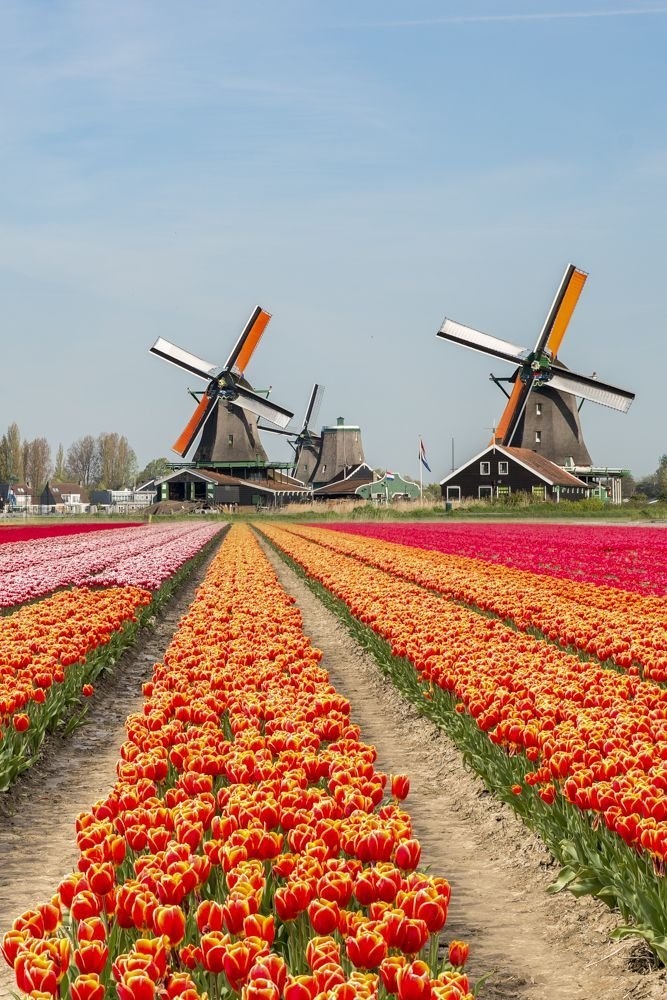
Travel Tips
Traveling to the Netherlands is a rewarding experience, but understanding local customs, safety advice, and language basics will make your journey smoother and more enjoyable. Here’s a comprehensive guide to help you navigate Dutch society with confidence.
Safety Advice
General Safety
The Netherlands is widely regarded as one of the safest countries in Europe. Violent crime is rare, and cities are well-policed. Petty crime, such as pickpocketing and bicycle theft, can occur, especially in busy tourist areas and train stations. Keep your belongings secure, avoid leaving valuables unattended, and always lock your bike with a sturdy lock.
Transport Safety
Public transportation is safe, efficient, and reliable. Be cautious when crossing bike lanes-cyclists have the right of way and move quickly. At night, trains and buses are generally safe, but it’s wise to remain alert and stick to well-lit areas.
Cycling Safety
If you rent a bike, familiarize yourself with Dutch cycling rules. Always use designated bike lanes, signal your turns, and avoid using your phone while riding. Helmets are not mandatory but can be worn for extra safety. Watch for tram tracks, which can be slippery, and always lock your bike securely.
Emergency Numbers
The emergency number for police, fire, and ambulance services is 112. Medical care is of high quality, and pharmacies (apotheek) are widely available.
Weather Precautions
The Dutch climate is temperate but can be unpredictable. Rain showers are common year-round, so carry a compact umbrella or rain jacket. In winter, sidewalks and bike paths may be slippery due to frost or ice.
Local Customs
Directness and Communication
Dutch people are known for their direct and open communication style. Honesty is highly valued, and people will often speak their minds without sugarcoating. This can come across as blunt to some, but it is not intended to be rude-rather, it reflects a culture of transparency and efficiency.
Greetings and Social Etiquette
- When meeting someone, a firm handshake and direct eye contact are customary. In social settings, it’s common to greet everyone in the room individually, including men, women, and children.
- Among friends and family, the Dutch may greet each other with two or three kisses on the cheek, alternating sides.
- When entering a waiting room or small shop, it is polite to say “goedemorgen” (good morning), “goedemiddag” (good afternoon), or “goedenavond” (good evening) to those present.
- When leaving, it’s polite to say goodbye to everyone as well.
Punctuality
The Dutch are famously punctual. Arriving late, even by a few minutes, is considered disrespectful. Always inform your host if you’re running late. Social appointments, meetings, and even casual get-togethers are often scheduled weeks in advance and entered into a personal “agenda” or diary.
Dining Etiquette
- Wait for the host to indicate when to start eating. The phrase “Eet smakelijk” (“Enjoy your meal”) is said before beginning a meal.
- Table manners are Continental: fork in the left hand, knife in the right. Keep your hands visible above the table, but elbows off the table.
- When making a toast, say “proost” and make eye contact with each person.
- If you’re invited to someone’s home, bring a small gift such as flowers, chocolates, or wine. Don’t expect your wine to be opened during the meal-hosts may save it for another occasion.
- It’s polite to offer to help clear the table or wash dishes, but the host will usually decline.
- The Dutch dine early, often around 6pm. If you’re not specifically invited for a meal, don’t expect to be served food.
Paying the Bill and Tipping
- Splitting the bill (“going Dutch”) is standard practice, even among couples and friends. Apps like Tikkie are commonly used to settle shared expenses.
- Tipping is not obligatory, but rounding up the bill or leaving a 5–10% gratuity for good service is appreciated.
Personal Space and Privacy
Dutch people value privacy and personal space. They may seem reserved at first and are unlikely to initiate conversation with strangers. However, they are friendly and open once approached. Avoid asking overly personal questions unless you know someone well.
Dress Code
Dutch fashion is casual, practical, and unpretentious. Jeans, comfortable shoes, and weather-appropriate layers are the norm. Business settings may require a suit and tie, but most social situations are informal.
Birthdays and Celebrations
Birthdays are important events. It’s customary to congratulate not only the birthday person (“Gefeliciteerd!”) but also their family and friends present at the celebration. Many Dutch keep a birthday calendar on display, often in the bathroom.
Other Social Customs
- Don’t point with your index finger; gesture with your whole hand instead.
- Cover your mouth when yawning, and don’t chew gum while talking.
- Smoking is prohibited in most public spaces. Always ask permission before lighting a cigarette, even outdoors.
- Sundays are considered family time, and unannounced visits are discouraged.
Language Basics
The official language is Dutch, but English is widely spoken, especially in urban areas and among younger people. Learning a few basic Dutch phrases is appreciated and can help you connect with locals.
Common Dutch Phrases:
Dutch | English Translation | Pronunciation |
Hallo | Hello | hah-loh |
Goedemorgen | Good morning | khoo-duh-mor-ghen |
Goedemiddag | Good afternoon | khoo-duh-mi-dakh |
Goedenavond | Good evening | khoo-duh-nah-vond |
Tot ziens | Goodbye | tot zeens |
Dank u wel | Thank you | dank oo vel |
Alstublieft | Please / Here you are | al-stu-bleeft |
Ja / Nee | Yes / No | yah / nay |
Spreekt u Engels? | Do you speak English? | spraykt oo eng-uhls? |
Hoe gaat het? | How are you? | hoo khaat ut? |
Proost! | Cheers! | prohst |
Eet smakelijk | Enjoy your meal | ate smak-uh-lik |
Gezondheid | Bless you (after sneeze) | khuh-zohnt-hate |
Tips for Language:
- Most Dutch people appreciate it if you try to use a few words of Dutch, even if your pronunciation isn’t perfect.
- Signs, menus, and public information are often in both Dutch and English, especially in tourist areas.
- If you need help, politely ask, “Spreekt u Engels?” (Do you speak English?)-most people will respond positively.
Final Tips for a Smooth Journey
- Be open and direct: Don’t be offended by straightforward comments; it’s a sign of honesty, not rudeness.
- Respect the environment: The Netherlands is clean and eco-conscious. Dispose of waste properly and recycle when possible.
- Plan ahead: Make appointments for social visits and respect people’s time and privacy.
- Enjoy local customs: Participate in Dutch traditions, try local foods, and embrace the cycling culture.
By keeping these tips in mind, you’ll find it easy to adapt and enjoy your time in the Netherlands, making meaningful connections and lasting memories along the way.

